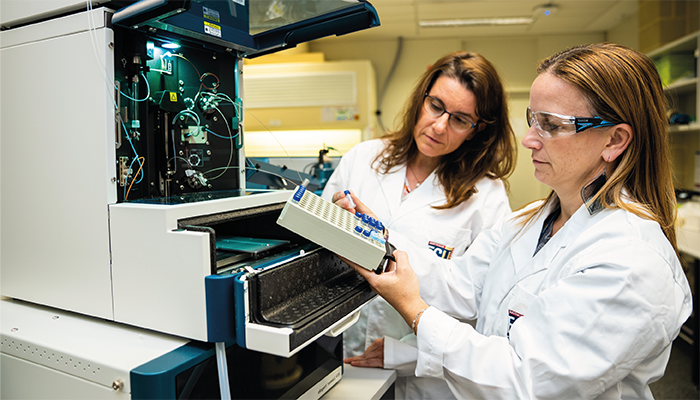International Mass Spectrometry Conference (IMSC) 2024 is set to take place in Melbourne, Australia, on August 17–23, 2024. In the leadup to the show, we’ll be chatting with some of the organizers and expert speakers to find out more about their research passions, what they’re most looking forward to at the show, and why you should seriously consider making the trip “Down Under.”
Here, we speak with Michelle Colgrave, IMSC Local Organising Committee member, Professor and Deputy Director (Impact) at The Commonwealth Scientific and Industrial Research Organisation (CSIRO), Agriculture and Food, Brisbane, Australia. Michelle discusses her work applying proteomics to agriculture and food science, as well as her tips as someone who grew up in Melbourne for those attending IMSC.

What gets you out of bed in the morning?
I am an analytical chemist by training but focus specifically on the study of proteins by mass spectrometry: proteomics. I have been referred to in the past as a “protein detective,” bringing together my interests in scientific exploration and application in agrifood systems for the benefit of industry and consumers – often considering food safety as a key outcome. In the past, I have explored a diversity of agricultural commodities and food products, including livestock welfare studies, reproductive biology in abalone, disease studies in salmon, development of gluten-free grains, engineering omega-3 canola, exploring cross-reactivity in seafood and insects, and exploring novel foods (made from underutilized crop, seaweed, algae, fungi, or other microbes). This diversity of scientific interests is drawn together by a common technology platform: mass spectrometry. And I am passionate about training young scientists in mass spectrometry and its applications. Watching these emerging leaders bring their skills and motivation to the use of mass spectrometry and associated bioinformatic analysis is exciting and fulfilling.
How exactly is proteomics connected to agriculture and food?
In my mind, food is the ultimate medicine. If we eat well, we set ourselves up for good health outcomes, but if we eat poorly, our risk of metabolic disorders or cardiovascular disease is increased. Moreover, food can contain components that can cause poor health (antinutritionals) or can enhance health (bioactives).
As an example, let’s consider gluten – the family of proteins found in cereal grains (wheat, barley, rye) that is of concern for people with celiac disease (CD). But how much gluten makes it into finished products is not always understood. Common tests used to measure gluten in food can lead to both false positives and negatives, thereby impacting industry unnecessarily or putting patients with CD at risk. Mass spectrometry offers a solution to detect these potentially harmful proteins and thus inform food manufacturers and regulators in an effort to safeguard the health of vulnerable consumers. We use the same approach to detect allergens, which are commonly protein triggers or to detect non-protein toxins that can cause sickness.
But not all foodborne proteins are bad – protein is, of course, a critical macronutrient needed for growth and development. But there are also specific proteins that can help with disease management – for instance, there are key proteins in lupin that assist with glycaemic control or blood pressure in people with type 2 diabetes.
Why did you decide to help with IMSC this year?
First and foremost, I wanted to ensure that the domain areas of agriculture and food science were included in the program, given the impact that can be delivered by addressing major challenges like food security and quality and their link to sustainable development goals. Secondly, I wanted to support the career development of early career researchers. One of the first international conferences that I attended was IMSC – in Barcelona over two decades ago. As a PhD candidate at that time, I was exposed to cutting-edge research trends and developments, I began to create my scientific network and I had the opportunity to present my research on a global stage. This experience was invaluable – and I wanted to play a role in providing this same opportunity for early career researchers to participate in an event showcasing the state-of-the-art in mass spectrometry application for impact science delivery.
What are you most looking forward to at IMSC 2024?
We have a stellar lineup of speakers with excellent diversity that will bring the action-packed program to life. But if you really want to know what I am looking forward to – it’s the networking. Connecting with colleagues from near and far, making new friends, and watching the magic of collaboration as people with different skill sets come together to tackle scientific challenges.
Will you be speaking at the conference? If so, what will you cover?
If I am accepted into the program, I will talk about how we use mass spectrometry to explore the safety and health benefits of future foods.
What’s your favorite thing about Melbourne?
I grew up in Melbourne, so I have many fond memories – riding the tram, attending AFL games (go Hawks), shopping and dining (great coffee in laneway cafes), or getting outside greater Melbourne to explore the outdoors – don’t forget the penguins…
Any tips for visitors?
The venue is super central, surrounded by hotels, restaurants, cafes, shops – in fact, it will be tempting to wander off to explore the precinct. So, my top tip is to book an extra day or two to explore the city and surroundings. And on August 16, you can go watch the mighty Hawks take on Richmond, so bring something brown and/or gold to wear!
For more information about IMSC 2024, visit: imsc2024melbourne.com




